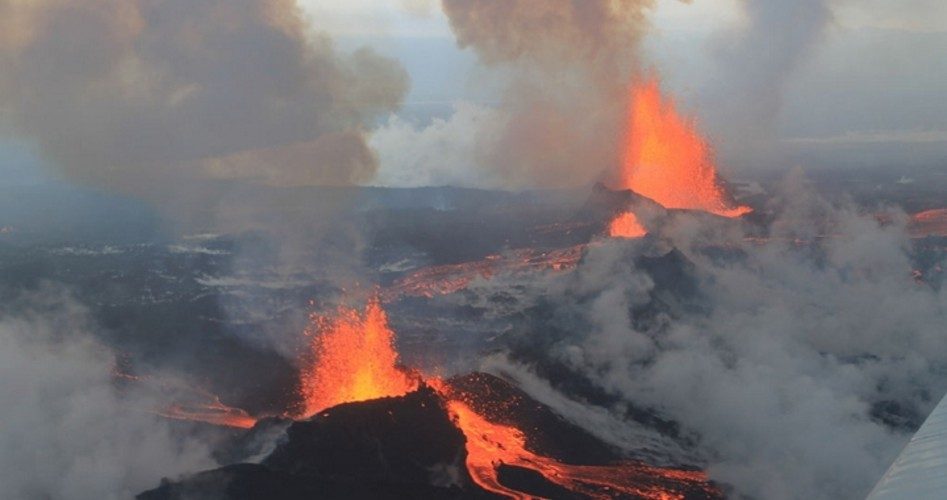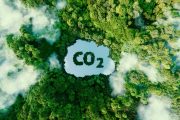
“The sulfur dioxide (SO2) emitted from the Holuhraun eruption has reached up to 60,000 tons per day and averaged close to 20,000 tons since it began,” notes Pall Stefanson, in a September 25 report for Iceland Review Online. “For comparison, all the SO2 pollution in Europe, from industries, energy production, traffic and house heating, etc., amounts to 14,000 tons per day.”
And the Holuhraun eruption, which began in late August, is but one of many active volcanic eruptions that Iceland, the land of fire and ice, has been experiencing lately. A few miles away, Iceland’s Bardarbunga volcano is also causing concern. A September 12 report for Iceland Review Online noted that SO2 from the eruption was four times the previous record and that residents were complaining of sore throats, stinging eyes, and headaches from the sulfur pollution.
Weather.com reported that sulfur fumes from the Icelandic volcanoes are even bothering people on Norway’s coast 800 miles away.
Anthropogenic Global Warming vs. Volcanic Global Cooling?
A report by the (U.K.) Express speculated that a major Bardarbunga eruption could bring on a mini ice age.
“Icelandic volcano could trigger Britain’s coldest winter EVER this year,” ran the Express headline, while the subtitle warned: “BRITAIN could freeze in YEARS of super-cold winters and miserable summers if the Bardarbunga volcano erupts, experts have warned.”
According to the Express report,
Depending on the force of the explosion, minute particles thrust beyond the earth’s atmosphere can trigger DECADES of chaotic weather patterns.
Tiny pieces of debris act as billions of shields reflecting the sun’s light away from earth meaning winter temperatures could plunge LOWER THAN EVER before while summer will be devoid of sunshine.
The first effect could be a bitterly cold winter to arrive in weeks with thermometers plunging into minus figures and not rising long before next summer.
The Icelandic Met Office has this week warned of “strong indications of ongoing magma movement” around the volcano prompting them to raise the aviation warning to orange, the second highest and sparking fears the crater could blow at any moment.
The region has also this week been hit by a magnitude-four earthquake — the strongest for almost 20 years, officials said.
The British Met Office said the effects of an explosion on Britain’s weather depends on the wind direction in the upper atmosphere.
Spokeswoman Laura Young said: “If the upper winds are north-westerly it will have an effect on our weather. “If the upper winds are westerly then it won’t.”
The newspaper’s sensationalizing aside, Iceland’s volcanic activity might — in rational minds — serve to draw attention to the natural variables (volcanoes, ocean currents, solar activity, clouds, water vapor, etc. ) that dwarf the human impact on climate. Australian scientist Ian Plimer — geologist and volcano expert, professor of geology at the University of Adelaide, and professor emeritus of earth sciences at the University of Melbourne — is one of the many scientists who have tried to inject sensible consideration of the effect that volcanoes and earthquakes contribute to the production of atmospheric CO2.
In a 2009 Op-Ed in The Australian entitled “Vitriolic climate in academic hothouse,” Dr. Plimer wrote:
To demonise element number six in the periodic table is amusing. Why not promethium? Carbon dioxide is an odourless, colourless, harmless natural gas. It is plant food. Without carbon, there would be no life on Earth.
The original source of atmospheric CO2 is volcanoes. The Earth’s early atmosphere had a thousand times the CO2 of today’s atmosphere. This CO2 was recycled through rocks, life and the oceans.
Through time, this CO2 has been sequestered into plants, coal, petroleum, minerals and carbonate rocks, resulting in a decrease in atmospheric CO2.
The atmosphere now contains 800 billion tonnes of carbon as CO2. Soils and plants contain 2000 billion tonnes, oceans 39,000 billion tonnes and limestone 65,000,000 billion tonnes. The atmosphere contains only 0.001 per cent of the total carbon in the top few kilometres of the Earth.
Deeper in Earth, there are huge volumes of CO2 yet to be leaked into the atmosphere. So depleted is the atmosphere in CO2, that horticulturalists pump warm CO2 into glasshouses to accelerate plant growth.
Our planet has about 1,000 volcanoes on land, such as Holuhraun and Bardarbunga, but most of our volcanoes are under the sea. “Some 85 per cent of volcanoes are unseen and unmeasured yet these heat the oceans and add monstrous amounts of CO2 to the oceans,” notes Dr. Plimer. “Why have these been ignored?,” he asks.
In a video lecture at the Institute of Geology and Geophysics at the University of Adelaide (which can be viewed here), Professor Plimer notes that the more than 10,000 earthquakes that occur each year release massive amounts of CO2 that has been sequestered in the various mineral formations. CO2 is but one of many variables that affect the climate, and its effect is very slight, in comparison to many other factors. Moreover, man’s contribution of CO2, SO2, and other greenhouse gases is relatively minor, when compared to the contributions from natural sources.
Photo of Holuhraun erupting on September 4, 2014
Related articles:
Govt Scientists Propose Nuclear War to Curb Global Warming
UN Climate Summit: Obama Unleashes Another Executive Order
CFR Globalists Join Enviro-socialists Pushing UN Climate Summit
Amid No Warming in 18 Years, “People’s Climate March” Ridiculed
Billionaires and Communists Plan “People’s Climate March”
With Ice Growing at Both Poles, Global Warming Theories Implode



